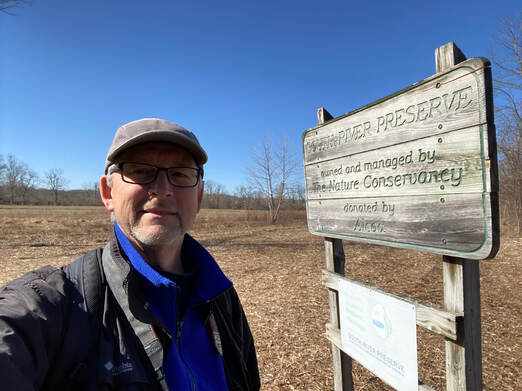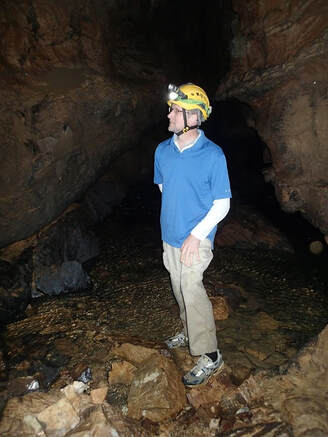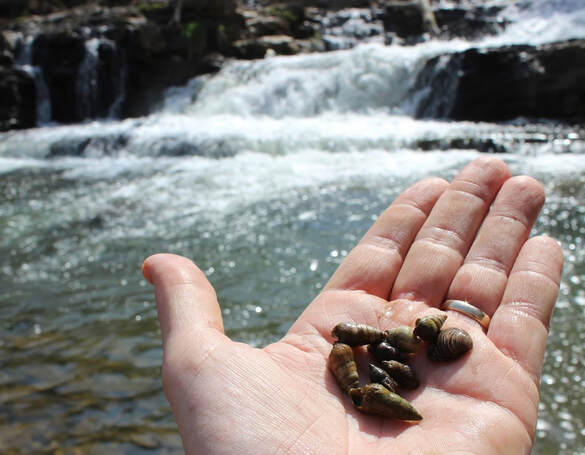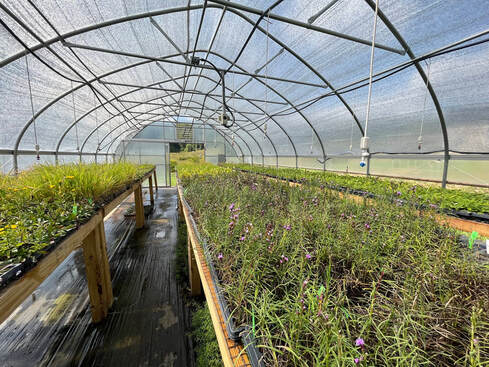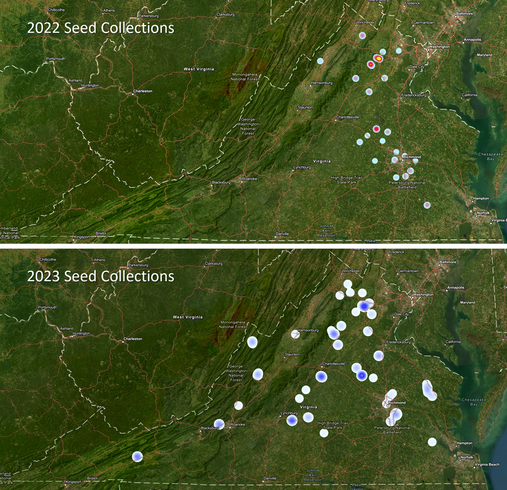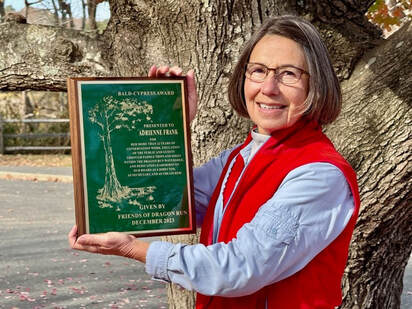 Adrienne Frank, VMN volunteer with the Historic Rivers Chapter, receives the Bald Cypress Award from the Friends of Dragon Run. Photo by Jeff Wright.
Adrienne Frank, VMN volunteer with the Historic Rivers Chapter, receives the Bald Cypress Award from the Friends of Dragon Run. Photo by Jeff Wright.
VMN Receives the The Bald Cypress Award
–Contributed by Connie Reitz, VMN-Historic Rivers ChapterAdrienne Frank is a member and officer of the board for the Historic Rivers Chapter of the Virginia Master Naturalists. She is a member of the
Golden Circle of VMN, having more than 5,000 volunteer hours with our organization. But Adrienne does so much more.
In December 2023, Friends of Dragon Run (FODR) awarded the Bald Cypress award to Adrienne Frank. In this group’s more than 38-year history, only a few Bald Cypress awards have been given.
The Bald Cypress award is the highest level of recognition made by FODR. This award recognizes a member’s superior contributions to FODR and his or her achievements in protecting, preserving, and encouraging the wise use of Dragon Run and its watershed—the mission of FODR.
Adrienne has been a volunteer with FODR for more than 22 years. She has helped to fulfill the mission of this organization by doing conservation work, educating the community while leading paddle trips and hikes, and being a dedicated leader on the board.
We want to share in the celebration of this award presented to Adrienne. We know of her passion to protect our natural resources. Thank you for all you do! Congratulations, Adrienne!
Volunteers in the News–Collected and quoted from various news sources
VMN volunteers are amazing people, and they frequently are engaging in newsworthy activities, both within and outside of their volunteer roles. We hear about them in the VMN State Office thanks to a Google Alert that notifies us of news articles that mention “Virginia Master Naturalist”. Here are a few of the latest examples!
- In an amazing example of getting to know one area well, Garnett Hudson, VMN-Southwestern Piedmont Chapter, has completed his 300th hike of the Rock Castle Gorge, a 10.8 mile hike in Floyd and Patrick counties. The Martinsville Bulletin featured a story about his accomplishment, stating, “He became a Virginia Master Naturalist a little over a year ago because of his sister Dottie Haley, who has been a member since 2009. This changed the way he experienced hiking on the trail because it increased his awareness of trash on the trail and also increased his interest in the birds he heard and saw there.” Way to keep getting out into nature, Garnett!
- Debbi Hale, VMN-High Knob Chapter, is making a difference in her community of Pound in Wise County. Pound nearly lost its status as a town, but is experiencing a turnaround, thanks to a number of leaders and community members, including Debbi. An in-depth article about Pound in Cardinal News states, “Hale, who has become Pound’s de facto head of recreation and tourism, believes the town can better capitalize on its outdoor amenities….Hale, who volunteers her time to help the town, spent her career as a teacher, not a fundraiser. But in recent years, she has become adept at piecing together grants to help pay for her vision, and at building relationships with those who can help her do it. The bear-proof trash can? A grant from the state Department of Wildlife Resources. The signage and information kiosk? A grant from the Nature Conservancy, with help from the arts and community development nonprofit Appalshop. More recently, Hale won a grant to buy four GRIT Freedom Chairs, which look something like a cross between a mountain bike and a wheelchair and allow people with limited mobility to explore off road. She has bigger projects in her sights. She’s thinking about where the town might create an RV park to attract more tourists, and about how to finish cleaning up the river where it runs through town to create a tubing course.”
- Clark Walter, VMN-Rivanna Chapter, was featured in a WVTF news story for his bluebird box building activities. Clark has built more than 4,000 bluebird boxes which he then sells for just the cost of the materials to people all over the state who want to provide homes to cavity nesting birds. Most recently, Clark helped mentor a high school student from Arlington in her Girl Scout Gold Award project, which involved establishing a bluebird trail at a local park. Clark also had an article about the student and their work together published in Bluebird, the journal of the North American Bluebird Society.
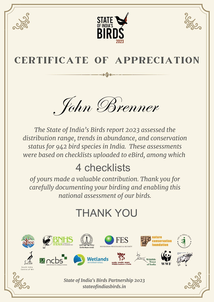
Birding on the Other Side of the World
Oftentimes, VMN Volunteers are making some pretty cool contributions outside of the program, too! John Brenner, VMN-Holston Rivers Chapter, visited India in 2023. Like many VMN volunteers, he did some birding on his travels and reported his observations to the eBird database. He later received a certificate of appreciation, because his data had been used to produce the State of India’s Birds Report. This is one of many examples of how VMN volunteers are making a difference, even beyond their role in our program.
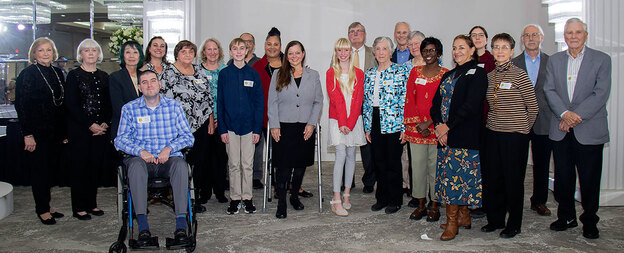
2024 Fairfax County Park Authority Outstanding Volunteer Award Winners. Photo courtesy of Fairfax County Park Authority.
Fairfax Master Naturalists Receive 2023 Elly Doyle Awards–Contributed by Jerry Nissley, VMN-Fairfax Chapter
Every year Fairfax County Park Authority and the Fairfax County Park Commission present awards to deserving volunteers or organizations. For 2023 two FMN volunteers received “Outstanding Volunteer” awards from the parks they support; and another received a Team Service Award for her 13 years of service.
FMN Celia Boertlein received both the Elly Doyle “Outstanding Volunteer” Award and the Huntley Meadows Park’s (HMP) “Ken Howard” award. Ken Howard was an autochthonal volunteer at HMP and this eponymous award is considered HMP’s highest honor. Her Elly Doyle nomination letter stated that Celia wears many hats and is nearly always the first volunteer to assist with programs. Celia continues to fulfill her roving naturalist and vernal pool monitor duties without fail and dedicates an incredible amount of time and energy to support HMP. Celia helped immensely with the HMP Wetlands Awareness Day as a Friends of Huntley Meadows Park representative organizing the event. She continually steps up as an interpretive program assistant, field trip leader, roving naturalist, and vernal pool monitor – she is an essential park volunteer. Celia contributed over 275 FMN hours to Huntley Meadows Park in 2023.
FMN Jo Doumbia received an award from Hidden Oaks Nature Center in the Annandale area. The nomination letter cited Jo’s enthusiastic demeanor, graciousness of sharing her multilingual skills, and her joy of fostering natural history education in support of environmental justice. Jo is the perfect example of an outstanding volunteer. The letter went on to say that she excels at her role inside the nature center building and took it upon herself to extend Hidden Oaks’ interpretative outreach activities to the local underserved community. Jo contributed 340+ FMN volunteer hours to Hidden Oaks in 2023.
FMN Betty Hoblitzell has worked with the Fairfax County Rapid Response Team for 13 years, attending some of the first organizational meetings in 2010. The Early Detection Rapid Response Team is ready to go on short notice team to combat the aggressive behavior of invasive plant species. The team leads surveys for Fairfax County Park Authority’s Invasive Management Area program and determines appropriate actions to take to protect and restore native habitat.
The challenge to parkland is endemic and volunteers provide essential assistance as invasive plants are discovered. When problem areas are identified, Betty and the team are sent to parks throughout the 24,000-acre park system to survey specific plants. They then post reports estimating invasive species density, treatment efforts, and a rough map of the infested area. In 2023, the team of stalwart volunteers gave more than 225 hours to Rapid Response teamwork, covering over 200 acres in a matter of months. Their work has curbed wavyleaf basket grass and multiflora rose incursions, stopping the spread early which conserves time, money, and other management resources.
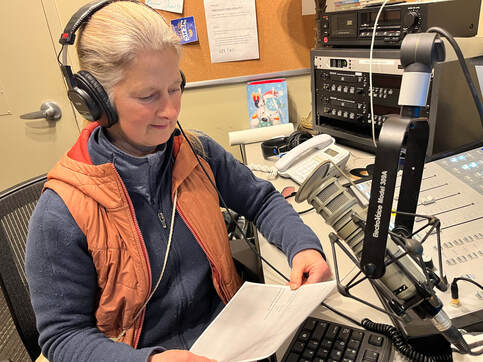 Holston Rivers Master Naturalist volunteer Terri Adkins was just one of many who has added her voice to the “E&H Wild Campus” radio promo spots, seen here in the studios of WEHC-FM. Photo courtesy of Monica Hoel
Holston Rivers Master Naturalist volunteer Terri Adkins was just one of many who has added her voice to the “E&H Wild Campus” radio promo spots, seen here in the studios of WEHC-FM. Photo courtesy of Monica Hoel
Nature on the Airwaves–Contributed by Monica Hoel, VMN-Holston Rivers Chapter
“Y’all…this place is WILD!”
That’s the line used to begin each of the Holston Rivers VMN public service announcements that are broadcast on WEHC-FM Emory 90.7/WISE-FM Wise 90.5.
The Emory & Henry campus radio station broadcasts NPR programing for a portion of the day and local programing for the remainder, and these recorded bits of nature education are peppered throughout local programming. The wildlife announcements are only about a minute in length and they serve to inform the community about some of the amazing critters that one might encounter in Southwest Virginia and the Emory, Virginia community in particular. Topics have included the acrobatics of the Belted Kingfisher that hangs out at the Emory & Henry duck pond, the wonders of the under-appreciated opossums who meander through local yards, the nighttime shrieks of foxes heard throughout the neighborhood, and the array of herons who frequent the campus. There was recently one on the topic of black bears aimed at calming the jitters during some recent mother-and-cub sightings.
The idea was hatched during the pandemic. The station manager at WEHC is a fan of nature and she asked if the Holston Rivers chapter might be interested in doing some short spots the station could use as space fillers between shows. It proved to be a volunteer project that Holston Rivers members could do while still staying safely apart. The earliest spots were recorded using rudimentary home-recording equipment, but the most recent installments have been done in the WEHC studios on campus. Holston Rivers members have had a great time volunteering in this unique format.
In addition to the radio spots, there is also a Facebook page where listeners can go and get a gander at some of the wildlife mentioned on the radio. The E&H Wild Campus page shares photos and links to the audio recordings folks may have missed.
WEHC recently had a signal expansion so that listeners now stretch from Marion to Wise. And with an easy way to listen online at www.wehcfm.com volunteers hope their messages are being heard around the globe.
Interpretive Trails – ENLIT Education Modules at the Rockfish Valley Foundation–Courtesy of the Rockfish Valley Foundation
Since 2005, the Rockfish Valley Foundation in Nelson County has achieved significant milestones in realizing its vision of environmental literacy by establis
hing three key facilities: Trails, Park, and the Natural History Center. The ENLIT project has three objectives; first, state-of-the-art infrastructure was developed on the trails. Next will come modules that will feature QR codes, providing immersive insights into the realms of water, rocks, plants, animals, culture, and history.
The installation of learning modules with QR Codes related to invasive plants and native trees and shrubs is set, thanks to the dedicated efforts of VMN volunteers Linda Hughes and Mary Voorees, collaborating with the Virginia Department of Forestry and the Virginia Blue Ridge PRISM, alongside the invaluable contributions of our Master Naturalist members. This collaborative project is a testament to RVF’s commitment to environmental education and community enrichment.
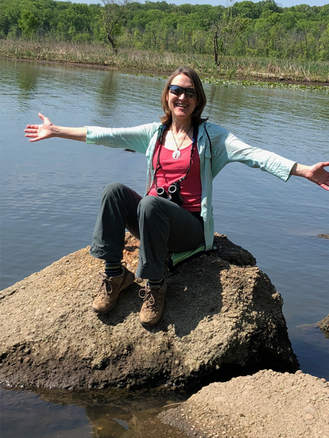 VMN volunteer Beth Kiser at Dyke Marsh. Photo by Paul Smith.
VMN volunteer Beth Kiser at Dyke Marsh. Photo by Paul Smith.
Beth Kiser Honored with Arlington County’s Bill Thomas Park Volunteer Award
–Contributed by Susan Berry, VMN-Arlington Regional Chapter
Beth Kiser (Arlington Regional Chapter) was presented in November with Arlington County’s Bill Thomas Park Volunteer Award for the year 2022. The award recognizes an individual or group whose efforts show ongoing dedication and tangible benefit to Arlington’s natural resources, parks, and public open spaces. Beth was honored for her work leading the ARMN Park Stewards program and conducting habitat restoration work, public education, and citizen science at multiple parks in Arlington, including NOVA Parks.
Beth Kiser was instrumental in the creation of the ARMN Park Stewards Program in 2018 and its subsequent expansion. The program trains and supports skilled volunteers to lead restoration of natural areas in parks in Arlington and other local jurisdictions. Beth has coordinated closely with other experienced volunteer leaders and Natural Resources staff, facilitated recruitment and mentoring of new Park Stewards, and fostered collaboration and communication among Park Stewards and park staff. With her leadership, the Park Stewards Program has grown to include dozens of natural areas, each supported by one or more Park Stewards, and a network of enthusiastic public volunteers.
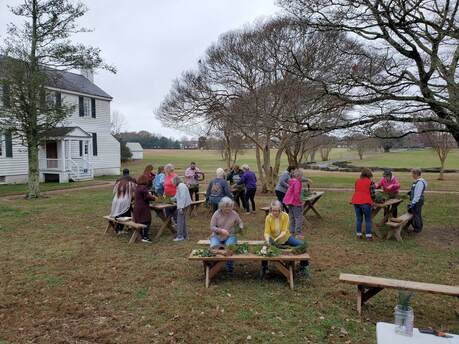 Wreath-making at Endview Plantation. Image by Daina Henry.
Wreath-making at Endview Plantation. Image by Daina Henry.
Peninsula Master Naturalists Lead Wreath-Making with Natural Materials
–Contributed by Daina Paupe Henry, VMN-Peninsula Chapter
One of our favorite activities/projects has been a cooperative venture with Historic Endview (a museum in Newport News). We offer grapevine wreath decorating events in December and have been doing so since 2016. Folks love coming to decorate handmade grapevine wreaths that PMN volunteers have pulled out of the trees in the area. In the summer we make the grapevines, and then in December Historic Endview has folks, for a small charge, decorate the wreaths with natural items that would have been found in the area. We gather pine, holly, magnolia leaves, cedar, juniper, cotton, oyster shells, dried fruits, pine cones, nuts and berries. We offer a lecture on decorating as it would have been done during the 1800’s and attendees get a tour of the historic home that is decorated for the period. We have many repeat customers, and families gather together to participate. And best, our volunteers who need hours, can get stewardship and outreach hours in December.
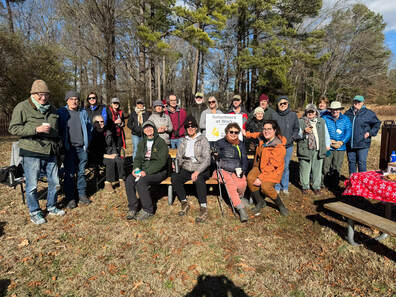 Jamestown Beach cleanup volunteers. Photo by Judy Jones.
Jamestown Beach cleanup volunteers. Photo by Judy Jones.
MLK Holiday Observance with Historic Rivers Master Naturalists–By Deborah Humphries and Connie Reitz, VMN-Historic Rivers Chapter
The national “Martin Luther King, Jr., National Day of Service” was started by former Pennsylvania U.S. Senator Harris Wofford and Atlanta Congressman John Lewis, who co-authored the King Holiday and Service Act. The federal legislation challenges Americans to transform the King Holiday into a day of citizen action volunteer service in honor of King. The legislation was signed into law by President Bill Clinton on August 23, 1994.
The Martin Luther King, Jr., holiday (Monday, January 15, 2024) is an official day of service and celebrates the civil rights leader’s life and legacy. The Virginia Master Naturalists (VMN) did not have a suggested volunteer activity for all chapters to do as a part of this observance. Members were asked only if they could volunteer with any approved local activity. The Historic Rivers Chapter (HRC) did make time with many volunteers.
The HRC has “adopted” several parks and trails for litter pickup. These include the Bassett Trace Nature Trail, James City County (JCC) Greensprings Interpretive Trail, JCC Powhatan Cree
k and Marina Parks, Mile #6 of the Virginia Capital Trail, and College Creek Beach on the Colonial Parkway (a part of the National Park Service).
On Saturday, January 13th more than 25 members of the HRC participated in a litter pick up activity at these areas of the Williamsburg and the JCC community. The team at College Creek Beach collected more than sixty pounds of litter. This volunteer activity was an appropriate way to observe the community service focus of the Martin Luther King, Jr. holiday.
The day was sunny and the temperature was great for outside activities. The wind—that was a force with steady breezes and gusts. There were white caps on the muddied and roiled James River. This provided the perfect setting as volunteers gathered at JCC Jamestown Beach Event Park for lunch and social time as well as cookies and cocoa after completing the litter pick up.
This may be the start of an annual chapter activity each year. Weather may be the unknown factor but this year we celebrated a day of service to honor the meaning of the holiday.
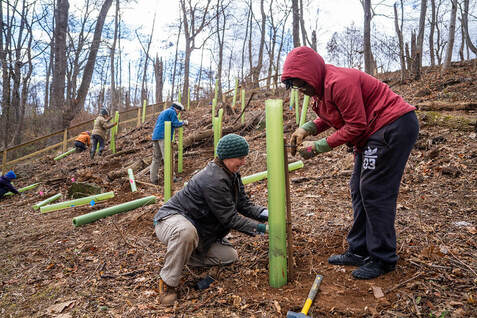 New trees protect Rush River water quality. Photo by Bonnie Beers.
New trees protect Rush River water quality. Photo by Bonnie Beers.
It Takes a Village: Multiyear collaborative projects bring community partners together to increase access to natural areas in Rappahannock County–Contributed by Charlene Uhl, VMN-Old Rag Chapter
During November and December, volunteers from Old Rag Master Naturalists (ORMN) joined others* through 2 ORMN projects: the Rappahannock County Recreational Facility Authority and the Sperryville Community Alliance projects– to plant over 330 native trees and shrubs in Rappahannock County Park and along the Sperryville Trail.
*Piedmont Environmental Council (PEC), Rappahannock County Garden Club, Rappahannock League for Environmental Protection (RLEP), Friends of the Rappahannock (FoR), and the community at large
Rappahannock County Park is a small gem in the constellation of the 43 county parks in Virginia. Established in 1978 by the County Board of Supervisors, this 7.3 acre park offers local residents and others a place to enjoy nature throughout the year. It is one of only three county parks in the U.S. to be designated as a Darks Skies Park by Dark Skies International. It is also certified as an Audubon Wildlife Sanctuary and is registered as a Homegrown National Park.
Over the past five years an expanding partnership of community organizations, supported by the Rappahannock County Recreational Facilities Authority, has worked to reclaim the Park’s forested area from invasive plants. Volunteers from ORMN have led the effort to identify and remove these noxious weeds and trees that offer little benefit to birds, insects, mammals or other wildlife. Between 2018-2021, efforts were limited to clipping, mechanical pulling and digging, followed by replanting in approximately 20% of the Park’s wooded area.
Because invasive growth in remaining wooded area was densely established on steep and rocky slopes above the Rush River, RCRFA obtained grant money to hire an eco-management firm to apply controlled chemical treatment and removal. After initial treatment in October, trustees from the RSW regional jail joined ORMN volunteers to clear debris in preparation for replanting. On December 6, more than 230 tree saplings and shrubs were planted in treatment areas.
The Sperryville Community Alliance has created a 2.5 mile walking trail along the Thornton River, beginning in the town of Sperryville and traversing private lands along the river. This project shares the objectives of the County Park to remove and control invasive plant growth, and to plant and nurture native growth. In November, over 100 tree saplings and shrubs were planted by ORMN and other community volunteers.
These restoration efforts involved hard work, including digging holes in rocky soil, setting the plants and installing protective tubing and netting, and mulching each and every plant. Volunteers were undeterred by freezing weather and the occasional snow showers!
Both projects were supported by the numerous community groups mentioned above. Funds and materials for the plantings were provided by the PATH Foundation, PEC, FoR, Culpeper Soil and Water Conservation District (CSWCD), Virginia Department of Forestry (VDOF), and the Rappahannock Garden Club.
While there is still work to be done, these partnerships have created remarkable changes the Rappahannock County Park and along the Sperryville Trail—the only 2 natural spaces in the County free and open to the public. Visitors can see black cherry, yellow poplar, persimmon, Virginia sweetspire, silky dogwood, white oak, spicebush and more. This transformation guides Rappahannock citizens and others to understand and appreciate the value of the natural systems that support native trees, shrubs, flowers and wildlife. And who knows – this may result in more people investing in native plants on their own property. And it took a true village to make this happen.
Historic Southside Chapter Receives $5000 Grant–Contributed by Beverley Ruegsegger, VMN-Historic Southside Chapter
In early December our chapter was informed that we were the recipient of a $5000 grant from Smithfield VA Events (SVAE). SVAE is an organization that has as its mission: “to bring well organized, first-class events to the Town of Smithfield and in doing so, support local non-profits, charities & civic groups and to strengthen our community by benefiting tourism and local business.” Among its many activities SVAE sponsors 3 main fundraising events at Windsor Castle Park (WCP) each year– Wine and Brew fest, Bacon and Burbon Music fest, and Beer, Oyster and Barbeque fest.
Part of the proceeds from these events is given back to the community in the form of grants awarded to eligible organizations which these organizations in turn use to benefit the Smithfield and Isle of Wight community. What a novel idea! How community minded! The grand total of donations SVAE made after the 1/13/2024 BOB fest was $1,675,866! Amazing.
To be eligible an organization must send its volunteers to help staff the events and be a 501c3. Our chapter acquired 501c3 status in 2022, and our chapter members have routinely volunteered as part of the support staff in these events over the past few years (e.g., washing table cloths, serving oysters and beer, checking tickets).
In early summer of this past year Henry McBurney took the lead in discovering what chapter projects might benefit
from a SVAE grant and after input from chapter members guided the grant application process. We were successful on our first try!! Congratulations chapter! The $5000 grant represents more than our annual budget! What a boost!
The funds from this grant are slated to be used in 5 projects, some at Windsor Castle Park (WCP) and others in other locations in Isle of Wight County. These projects are:
- Replace current interpretative signs in WCP. These 15+ signs have deteriorated over the past 5 years and need replacement.
- Install new interpretative signs identifying significant tree and flora in WCP.
- Replace Bluebird nest boxes at WCP. These 17 BB boxes are 10 years old and need replacing.
- Install bat houses at WCP, Nike Park and Camptown Park.
- Acquire bat monitoring equipment for use in various areas of Isle of Wight County. Data gathered will become part of a national database to document bat numbers which have been significantly declining.
Can you see how the funding for these projects benefits our natural communities and also promotes better public awareness of our environment not only for their enjoyment but also for their stewardship? What a good reminder for us of the value of what we are doing as a chapter and of continuing to think proactively about what areas we can be involved in.
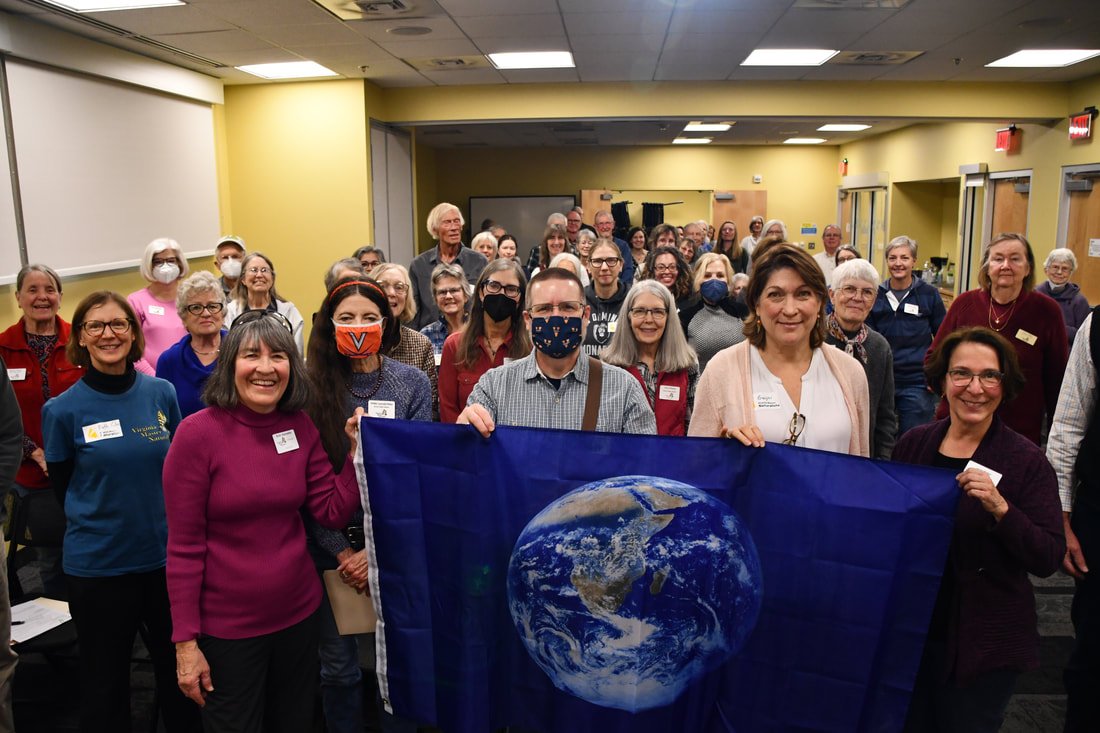
Rivanna Master Naturalists with the Earth Flag presented by the Sierra Club. Photo by Pat Klima.
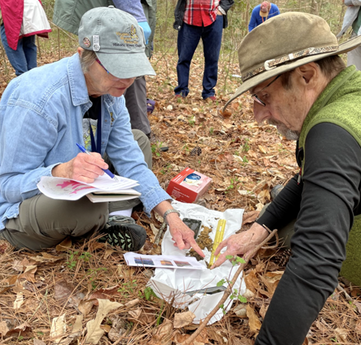 VMN volunteers spend time learning in the field in order to observe nature firsthand and practice their naturalist skills. Photo courtesy of Connie Reitz.
VMN volunteers spend time learning in the field in order to observe nature firsthand and practice their naturalist skills. Photo courtesy of Connie Reitz. 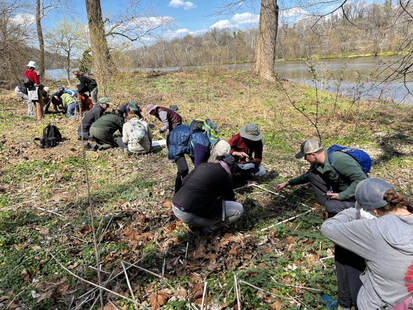 Lower Potomac Gorge Ecosystem Monitoring – Volunteers are using a 1-meter square quadrat and placing it according to strict rules in a random fashion so the results can be generalized. By doing so, ARMN and the NPS will be observing the changes in vegetation that occur after invasive removal and learning about techniques that work or do not work in the process. Photo by Joy Tobin.
Lower Potomac Gorge Ecosystem Monitoring – Volunteers are using a 1-meter square quadrat and placing it according to strict rules in a random fashion so the results can be generalized. By doing so, ARMN and the NPS will be observing the changes in vegetation that occur after invasive removal and learning about techniques that work or do not work in the process. Photo by Joy Tobin. 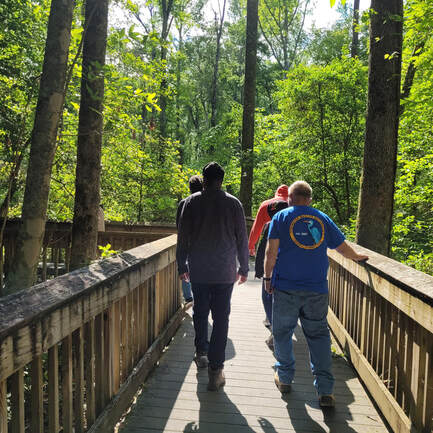 Virginia Master Naturalists in the Tidewater Chapter lead local community members on a nature and history walk at Great Dismal Swamp National Wildlife Refuge. Photo provided by Beth Deir.
Virginia Master Naturalists in the Tidewater Chapter lead local community members on a nature and history walk at Great Dismal Swamp National Wildlife Refuge. Photo provided by Beth Deir.
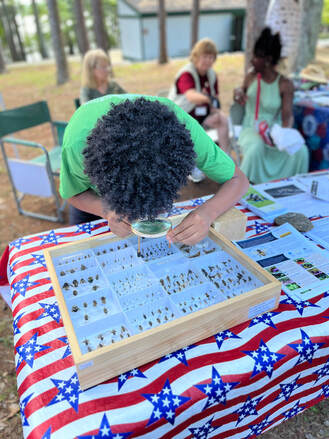 Southern Piedmont Master Naturalists partnered with Occoneechee State Park for a ‘Pollinators in the Park’ event, offering a chance for visitors of all ages to learn about the importance of bees, butterflies, and other pollinator species.
Southern Piedmont Master Naturalists partnered with Occoneechee State Park for a ‘Pollinators in the Park’ event, offering a chance for visitors of all ages to learn about the importance of bees, butterflies, and other pollinator species.

